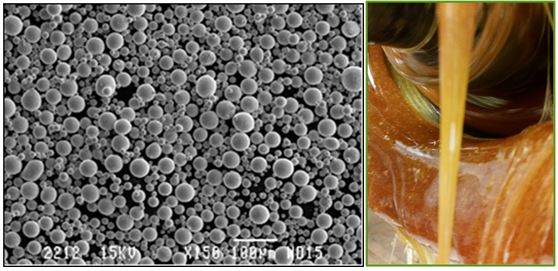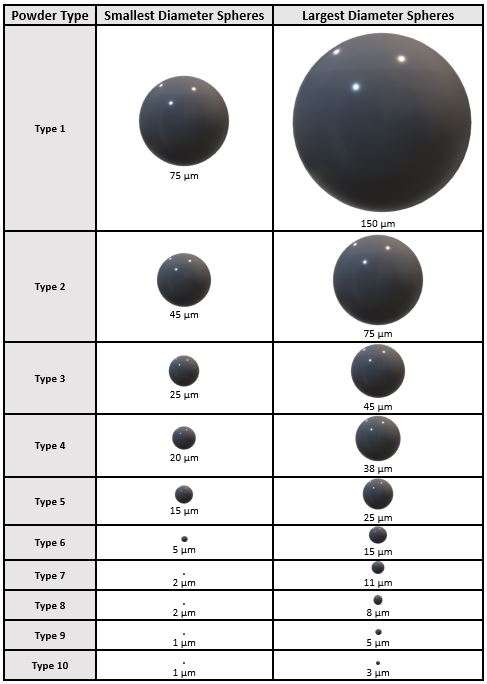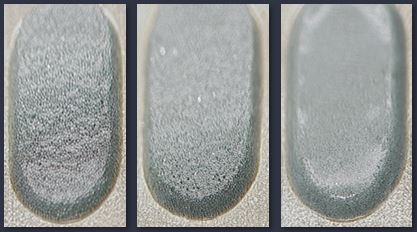如果您遇到过有关 4 型、5 型或 T4、T5、T6 的字样,请点击此处。 焊锡膏 并想知道这意味着什么,那你就来对地方了。
首先,请注意,虽然 焊锡膏 焊锡膏可能看起来像一个均匀的灰色圆球,但实际上它是一种经过精心设计的金属粉末和一种叫做助焊剂的粘稠介质的混合物。金属粉末赋予焊膏结构和功能,而助焊剂则使其在回流过程中流动并附着在元件上。
当有人谈到 "Type 4 焊膏 "或 "T4 焊膏 "时,他们指的是焊膏中粉末状金属颗粒的大小

在本文中,我们将介绍什么是不同尺寸的粉末,以及为什么我们首先要使用这些不同尺寸的粉末。
相对尺寸概述
放大显微镜观察,粉末呈微小球体状。每种粉末的尺寸或类型都有一个最小和最大的球形尺寸。 这些球体尺寸以微米为单位,1 微米 (µm) = 0.000001 米。 下表列出了每种粉末的最小和最大球形尺寸,并给出了这些球形的相对尺寸。
锡膏或锡粉分 1 类(最大)到 10 类(最小)。但如果我们从 10 开始,并希望制造出越来越小的颗粒,那么在降到 1 之后,我们就无法继续下去了。相反,我们可以在未来继续增加数量--11 型、12 型等--尽管这些类型还不真正存在。
作为参考,1 型粉末的直径在 75-150 微米之间,与人的头发直径差不多。10 型粉末的直径为 1-3 微米,与细菌或细胞器大小相当。

为什么粉末大小很重要?
粉末颗粒的大小会影响焊膏在实际应用中的性能。较小的颗粒能使锡膏流过更细的钢网孔径,这在元件和 PCB 越来越小的情况下是必不可少的。但是,更细的颗粒也有其局限性,比如更容易氧化,需要更严格的工艺控制。

电子行业的需求总是在不断变化,其标准也是如此。不久前,3 类焊膏(粒度:25-45 µm)还是标准。它对 0805 和 0603 等较大的元件效果很好。
随着元件越来越小、越来越紧密,Type 4(20-38 µm)成为首选标准,支持 0201 和 0.5mm BGA 等更精细的间距。如今,大多数 SMT 组装线都采用 Type 4。
但微型化的步伐并未放缓。现在,我们看到的是向 5 型(15-25 微米)甚至 更细的粉末,如 6 型 (5-15 µm) 的尖端技术,如微型 LED、芯片级封装和先进的系统级封装 (SiP) 设计。
如何选择合适的粉末大小
这里有一条经验法则:坚持使用应用所允许的最大粉末尺寸。较小尺寸的粉末精度高,但成本较高,工艺要求较严格。
为指导您做出决定,请考虑
- 5 球规则 最小的钢网孔径应至少是最大粉末颗粒直径的五倍。例如,4 型可处理的孔径最小为 ~190 微米,而 5 型可处理 ~125 微米。
- 您的组件 如果您使用的是 0201 或 0.5 毫米 BGA,4 型通常就足够了。对于 01005 或超细间距元件,则可能需要 5 型或更细。
- 您的设备 印刷和回流焊工艺可能需要针对更细的粉末进行调整,例如降低刮刀压力或优化回流焊气氛。
如需了解更多详细信息,您还可以阅读我们的技术文件 锡膏粉:何时减少用量.
最终想法
随着电子产品的不断缩小,锡膏粉末的尺寸变得比以往任何时候都更加重要。了解您所需的尺寸及其原因,可帮助您避免生产问题并确保可靠的组装结果。
数十年来,AIM Solder 一直在制造和完善焊粉,提供从 3 型到 7 型及更多型号的全系列焊粉。无论您是坚持使用行业标准的 4 类焊粉,还是升级到更精细的焊粉,我们都能帮助您根据制造需求做出正确的选择。
了解焊膏粉末的大小看似是一个小细节,但在电子产品世界中,这些细节却决定了一切。有更多问题? 给我们留言 - 我们帮助您更聪明地焊接,而不是更辛苦地焊接!





